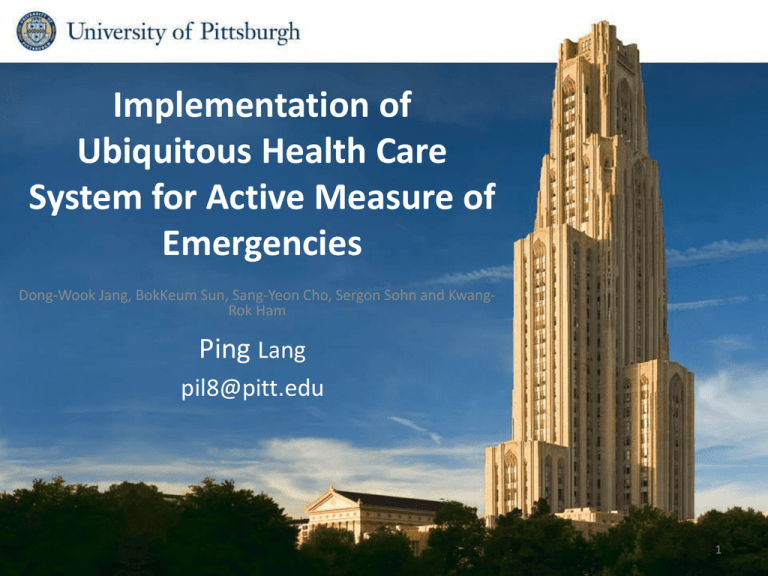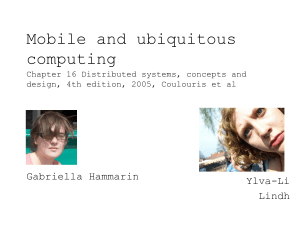Ping Lang
advertisement

Implementation of Ubiquitous Health Care System for Active Measure of Emergencies Dong-Wook Jang, BokKeum Sun, Sang-Yeon Cho, Sergon Sohn and KwangRok Ham Ping Lang pil8@pitt.edu 1 Content • About the paper – – – – – Motivation Solution Design of Ubiquitous Health Care System Experimental Results Conclusion • My point of views • Comparison with other papers 2 Motivation • Rapid development of ubiquitous technology • People are expecting ubiquitous technology to spread to every part of human life • Increasing number of chronic disease, heart disease and other new diseases • Rising death number caused by these diseases while lives can be saved if the emergences are will coped 3 Solution This paper implemented a Personal Health Care System (PHCS) based on Ubiquitous Sensor Network (USN) – Monitors patients’ condition continuously – Ubiquitous Health Care System (UHCS) When emergency happens, sends a text message containing the emergency code and location information to the caregiver and hospital to get prompt first-aid treatment 4 Design of Ubiquitous Health Care System ----System Configuration The structure of UHCS • Personal Health Care Host – Measures and analyzes data about the patient • Control Center – Collects patients’ condition data and stores them • Ubiquitous hospital & Caregiver – Gets reports on patients’ conditions periodically and takes prompt actions in emergency 5 Design of UHCS ----Core part of UHCS: PHCH Functional diagram of personal health care host 6 Design of UHCS ----Core part of UHCS: PHCH • PHCH is built as an embedded system using Intel Xscale CPU It receives data from each module and sends data to Control Center • Electronic stethoscope module Records and processes patients’ heart sound and bowel sound using an electronic stethoscope • Wireless sensors Monitors patient condition using USN such as accelerometers and vibration sensors • Position tracking module (GPS) Collects patient location information • Communication Module (CDMA) Send GPS information and patients’ emergency information to hospital and caregivers • RFID Stores and manages patients’ basic information in a RFID tag 7 Design of UHCS ---- Implementation of Electronic stethoscope Module • Electronic stethoscope is connected to PHCH by USB interface and the signal is amplified over 15 times by using operational amplifier • Noises are removed using a FIR filter 8 Design of UHCS ----Implementation of Patient state monitoring module • Patient state monitoring module analyzes data obtained from the sensor network including vibration sensor, acceleration/inclination sensor and temperature sensor • USN and PHCH communicate with each other through Zigbee • The module detects emergency based on received data Vibration sensor Acceleration sensor Temperature sensor Zigbee module 9 Design of UHCS ----Implementation Communication module Communication routes for emergency test messages in ubiquitous environment • In emergency, PHCH connects to the data line of a telecommunication carrier through CDMA and sends a text message to the designated hospital. 10 Design of UHCS ----Emergency codes • Due to the short text message limitation, some interpretation codes are proposed to indicate specific situation of the patients. 11 Design of UHCS ----Control Center and Emergency Center of Hospital • CC stores data of the patients sent from PHCH. Emergency center of hospital receives the text messages, decodes the emergency interpretation codes and informs people to take prompt actions. 12 Experimental Results for Ubiquitous e-Health System ----Emergency Monitoring 13 Experimental Results for Ubiquitous e-Health System ----Emergency Monitoring Waveform of acceleration and vibration sensors for normal walking Waveform of acceleration and vibration sensors for convulsion Waveform of acceleration and vibration sensors for syncope 14 Experimental Results for Ubiquitous e-Health System ----Emergency Detection Based on Sensor Data Back-propagation Network Learning 15 Back-propagation Network Learning Two Key points of the model: 1. Sufficient input data 2. Training times More units can pass more information Calculated output - =e The more input units the more sufficient input data Desired output Reference: Beiye Liu Miao Hu ; Hai Li ; Zhi-Hong Mao ”Digital-assisted noise-eliminating training for memristor crossbar-based analog neuromorphic computing engine” Design Automation Conference (DAC), 2013 50th ACM / EDAC / IEEE 16 Experimental Results for Ubiquitous e-Health System ----Emergency Detection Based on Sensor Data Back-propagation Network Learning Assuming sufficient number of units, the model can learn for a continuous function model Calculated output - =e Patients’ state received from USN sensors Desired output 17 Experimental Results for Ubiquitous e-Health System ----Emergency Detection Based on Sensor Data Learning & Detection System Architecture The parameter values of back-propagation network 18 Experimental Results for Ubiquitous e-Health System ----Emergency Detection Based on Sensor Data Evaluations • The recall ratio is not very high • The precision is not 100% accuracy • More optimized internal parameters through additional experiments are needed * Statistical measurement methods are introduced on next slide 19 Sensitivity and specificity • Sensitivity and specificity are statistical measures of the performance of a binary classification test, also known in statistics as classification function. • Sensitivity (also called the true positive rate, or the recall rate in some fields) measures the proportion of actual positives which are correctly identified as such • Specificity measures the proportion of negatives which are correctly identified as such • For example: A study evaluating a new test that screens people for a disease. Each person taking the test either has or does not have the disease. The test outcome can be positive (predicting that the person has the disease) or negative (predicting that the person does not have the disease). True positive: Sick people correctly diagnosed as sick False positive: Healthy people incorrectly identified as sick True negative: Healthy people correctly identified as healthy False negative: Sick people incorrectly identified as healthy Reference: http://en.wikipedia.org/wiki/Sensitivity_and_specificity H. Witten and E Framk, "Data Mining: Practical Machine Learning Tools and Techniques with Java Implementations", Morgan Kaufmann Publishers, 1999. 20 Experimental Results for Ubiquitous e-Health System ----Emergency Detection Based on Sensor Data Evaluations True Positive: Emergency happens and detected False Positive: No emergency happens but fake emergency detected False Negative: Emergencies happens but detected as no emergency • The recall ratio is low • The precision is not 100% accuracy • More optimized internal parameters through additional experiments are needed 21 Experimental Results for Ubiquitous e-Health System ----Communication Protocol • Text messages are sent to the emergency center via the wireless mobile network using CDMA air interface • Messages includes GPS information of the PHCH which is carried by the patients Communication protocol between CDMA communication module in PHCH and emergency center in hospital 22 Conclusion • The paper present a study discussed a ubiquitous health care system using USN, GPS, CDMA and RFID modules • With the system, a hospital can diagnose patients’ condition remotely by using and electronic stethoscope and transmitting patients’ heart, chest and bowel sound. • Using USN, the system can detect chronic disease patients’ emergencies such as syncope and convulsion. • Experimental results are delivered. 23 My point of view Superiorities of this paper: Using Back-propagation Network Learning to detect the emergency situation is more accurate and scientific Using vibration sensor to detect convulsions is creative Using both acceleration sensor and vibration sensor enhanced the accuracy Weakness Power consumption about the Personal Health Care Host (carried by the patients) is not mentioned USB connection between the embedded system and E-stethoscope is not very practical The emergency codes are totally not useful or helpful The accuracy about the false positive (test cases are not well covered) 24 Experimental Results for Ubiquitous e-Health System ----Emergency Monitoring Waveform of acceleration and vibration sensors for normal walking Waveform of acceleration and vibration sensors for convulsion Waveform of acceleration and vibration sensors for syncope 25 Comparison with other papers Good ideas from other paper: Using an independent host to collect data from sensors and do the emergency detection to solve the power consumption problem Using heart-rate sensor rather than electronic stethoscope to be more convenient for patients to wear Using both outdoor and indoor location to get the position of a patient Add more sensors (gravity vector & magnetic field vector)to detect more emergency situations, eg. fall-down issue Having a camera in the system to have detailed info about the emergency situation Y Using wifi to transfer data when wifi signal is detected X Z Normal condition X Z Y Y Y Z Fall condition I Fall condition II X Z X Fall condition III 26 Reference • http://en.wikipedia.org/wiki/Sensitivity_and_specificity • H. Witten and E Framk, "Data Mining: Practical Machine Learning Tools and Techniques with Java Implementations", Morgan Kaufmann Publishers, 1999. • Beiye Liu; Miao Hu ; Hai Li ; Zhi-Hong Mao “Digital-assisted noise-eliminating training for memristor crossbar-based analog neuromorphic computing engine” Design Automation Conference (DAC), 2013 50th ACM / EDAC / IEEE • Baiyi Chen; Chengliu Li; Zhi-Hong Mao “Designing a wearable computer for lifestyle evaluation” Bioengineering Conference (NEBEC), 2012 38th Annual Northeast • Ryu Gyeong-sang, “Development Trend and Prospect of Ubiquitous Society,” Ubiquitous Research Series No. 1, National Information Society Agency, p3, 2006






